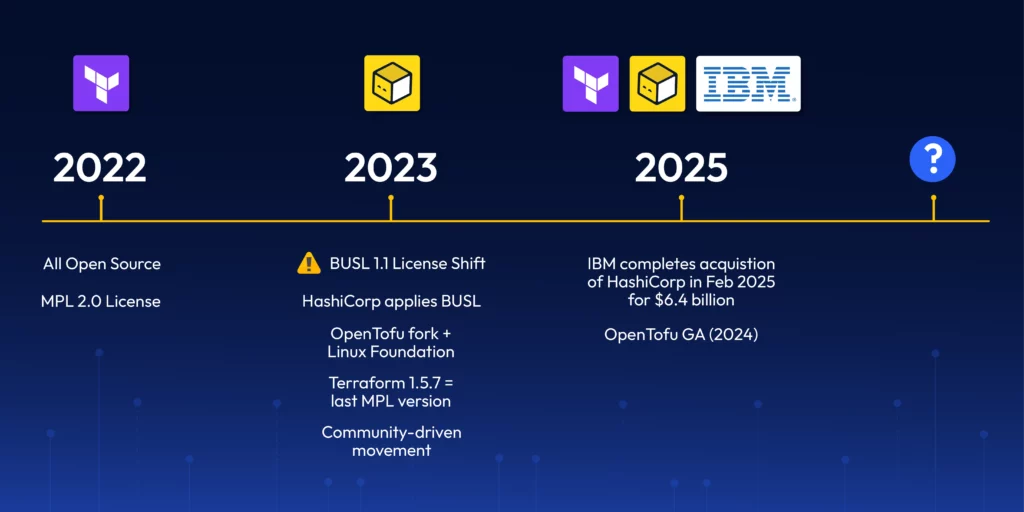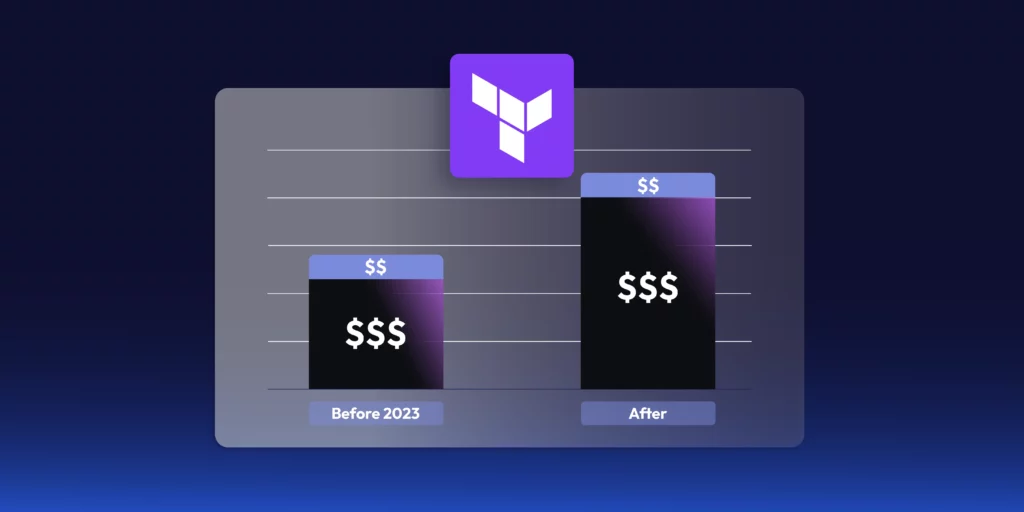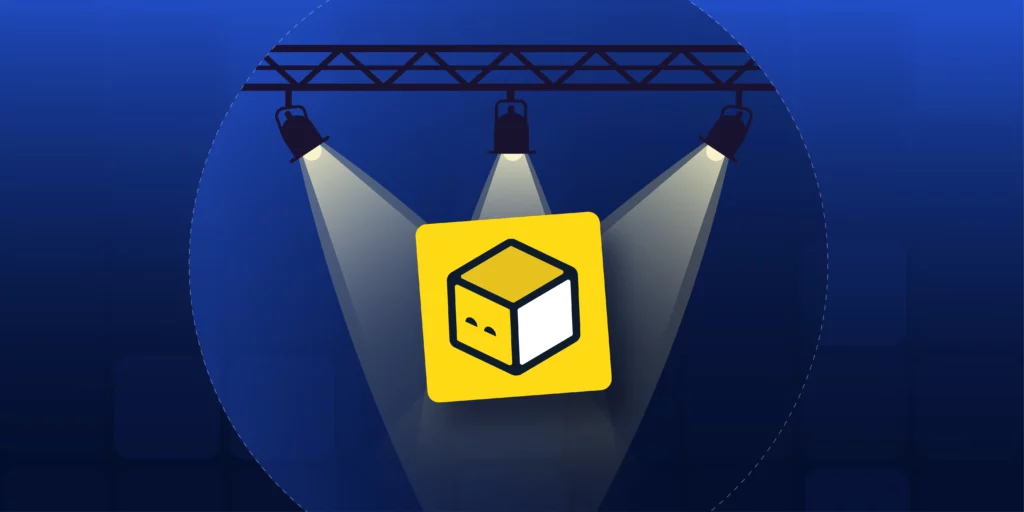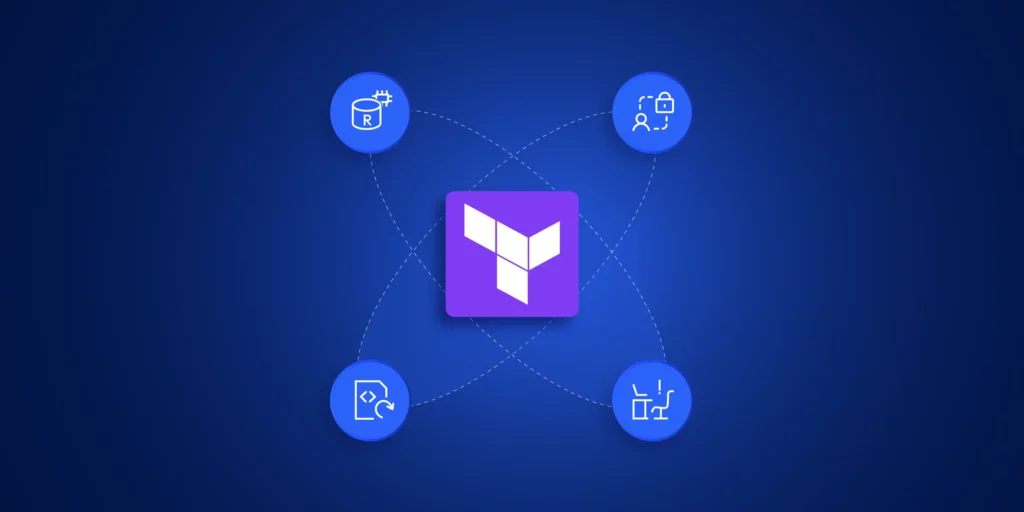Terraform’s license modification from Aug 2023 has prompted much debate in the DevOps and infrastructure-as-code (IaC) communities. Terraform License Change is more than just a legal update; it represents a change in how teams can use and contribute to one of the most popular IaC tools.
HashiCorp moved Terraform to the Business Source License (BUSL) v1.1, a source-available license that changes the rules for commercial use. Under BUSL, teams can continue using Terraform for free in internal projects. However, it restricts companies from offering Terraform as a managed service without a commercial agreement with HashiCorp.
Whether you’re using Terraform already or just exploring options, staying on top of license updates will help you stay flexible and avoid unexpected roadblocks.
Disclaimer: ControlMonkey is an alternative to Terraform Cloud, offering a modern, enterprise-ready platform for Infrastructure as Code automation and governance.
👉 Click here to see how ControlMonkey compares to Terraform Cloud
Why Has the Terraform License Changed?

In 2023, HashiCorp announced it would license Terraform under the Business Source License v1.1 (BUSL 1.1), marking a significant shift in how the tool is distributed and used. Unlike an OSI-approved licence, BUSL 1.1 still lets most teams use Terraform free for internal workloads, but it blocks hosting or embedding Terraform in a cloud service that competes with HashiCorp’s own Terraform Cloud or Enterprise offerings. For example, cloud providers can’t just offer Terraform as a managed service unless they have a contract with the license holder.
Why was this change made? The license holder aims to protect its business model while allowing the community to use Terraform widely. For most teams, nothing changes in how they use Terraform day-to-day. If your company plans to offer Terraform as part of a customer-facing service, you’ll likely need a separate commercial agreement with HashiCorp—a hurdle noted by Gruntwork, which advised customers to stay on Terraform v1.5.7 or lower (the final MPL-licensed release) and evaluate OpenTofu while the licensing landscape stabilises. For DevOps teams navigating the terraform license change, understanding where commercial-use boundaries lie is crucial to staying compliant.
If you run Terraform at enterprise scale, it’s worth reading BUSL 1.1 closely: each source file automatically re-licenses to MPL 2.0 four years after publication, but HashiCorp can still publish new Terraform releases under BUSL.
Learn more on Terraform Cloud and how to scale
-
What is Terraform Cloud →
Offers, Benefits, and Limitations
-
Terraform Cloud Pricing Guide: →
Tiers, Costs, and Optimization Tips
-
What Is OpenTofu? →
Step-by-Step IaC Guide for 2025
Terraform License Change: Impact on DevOps Teams
This licensing change has several important implications for DevOps teams who use Terraform to manage cloud infrastructures. Most internal teams who use Terraform for infrastructure automation will not notice substantial changes; the terraform business source license currently allows for free use in those cases.
The scenario differs if you use Terraform to construct commercial products, services, or platforms. You may need to review the licensing conditions carefully and sometimes negotiate with the license holder to get suitable usage rights.
This tendency may influence corporate governance rules and CI/CD procedures, especially for companies worried about vendor lock-in. Teams should now include licensing awareness as part of their DevOps strategy, alongside security and scalability.
Open Ecosystem Momentum: Exploring Terraform Open Source Alternatives
After Terraform’s licence change, many in the open-source community started exploring alternative tools that are community-driven and open by design. These alternatives emphasise flexibility and transparency—key if you want to avoid surprise licence shifts. Interest in fully open forks has surged; for example, OpenTofu, now a Linux Foundation project, has over 140 corporate backers and more than 13 k GitHub stars since its 2023 launch.
What’s pushing this movement isn’t just about saving money. It’s also about keeping control and being free to tweak things as needed. Open-source projects move faster, and you can customize them to fit pretty specific needs.
If staying open and future-proof with your infrastructure tools matters, keep tabs on terraform open source alternatives gaining traction. They allow teams to stay nimble without getting stuck under one company’s licensing terms.
4 Practical Ways to Stay Flexible After the Terraform License Change
With the landscape-altering, it’s prudent to future-proof your infrastructure strategy. That entails developing IaC tactics that aren’t overly reliant on any one instrument or license.
Here are some tips:
Support several IaC frameworks.
Making sure your automation platform is designed to work with several IaC platforms makes it easier to pivot as needed.
Utilize modular, provider-agnostic code.
Avoid tightly tied dependencies and use open standards whenever possible.
Monitor changes in the ecology.
Licensing models can evolve rapidly. Staying connected with the IaC community allows you to react quickly.
Assess alternatives proactively.
Even if you aren’t ready to switch, understanding your options puts you in a better position for the future.
Ultimately, the terraform license change serves as a turning point in how infrastructure tooling is governed.
Conclusion: Adapting to Terraform’s Licensing Change in IaC
Terraform’s switch to HashiCorp’s BUSL 1.1 is a significant moment for the infrastructure-as-code ecosystem. Most teams won’t see an immediate impact, but it’s a solid reminder to keep flexibility and openness front and center in your DevOps plans.
How do you deal with this terraform business source license shift?
Keep yourself updated, be ready to switch things up when needed.
ControlMonkey helps enterprises navigate Terraform licensing and IaC governance. Get time with us.

A 30-min meeting will save your team 1000s of hours
A 30-min meeting will save your team 1000s of hours
Book Intro Call
Sounds Interesting?
Request a Demo




